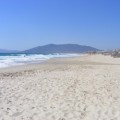Almeria Province
The province of Almeria is a strange corner of Andalucia. It is Spain’s hottest province with summers starting before April and lasting well into late October. It boasts the highest hours of sunshine and the lowest rainfall.
The capital of the province, Almeria City, has long sandy beaches (unfortunately it was very windy on our road trip here and we couldn’t sunbathe) and has an Arabic feel to it.
The coast also includes the popular tourist resort of Mojacar. With its coastline and mountains Mojacar provides the best of both, in a traditional whitewashed village plus beaches.
Also on Almerias coast is the Cabo de Gata national park. Being on the coast it is one of the only natural parks which include a marine reserve.
Inland its semi desert landscape is sparsely populated. Numerous films, including Lawrence of Arabia, were shot here. Near the town of Tabernas you can visit Mini Hollywood where several film sets have been preserved.
Parts of this desert demonstrate exciting geological features and a rich prehistoric past.
North of the province, you’ll find Las Millares, which is an exceptional archaeological site, and is considered to be Europe’s largest Bronze Age settlement. The site covers approximately 190,000sq.metres enclosed within four lines of defensive walls.
Further north and to the eastern end of the province is the Sierra María – Las Vélez Natural Park. Its natural heritage consists of an extensively wooded area, mainly pines, and unique and varied flora.
The Sierra offers an extensive variety of plant communities, partly due to the soil characteristics. The forest of Sierra María is populated by Aleppo pines and indigenous forests of maritime pines.
A must visit site is the Cueva de los Letreros, a Unesco World Heritage site which is the parks most well known cave with some of Europe’s most spectacular cave paintings.
To get to the caves follow the A317 north until you see the signs. Follow the path for a good kilometer until you reach the compound gate.
Once inside the compound you will be astounded by the paintings dated 4000B.C.



